Content for TS 23.434 Word version: 19.2.0
0…
4…
5
6…
6.4…
6.5…
6.5.3…
7…
8…
8.2.2…
9…
9.3…
9.3.2.21…
9.3.3…
9.3.6…
9.3.11…
9.3.13…
9.3.14…
9.4…
9.4.6…
9.5…
10…
10.3…
10.3.2.22…
10.3.3…
10.3.7…
10.3.10…
10.4…
11…
11.3…
11.3.3…
11.4…
12…
12.3…
13…
14…
14.2.2.2…
14.3…
14.3.2.20…
14.3.2.40…
14.3.3…
14.3.3.3…
14.3.4…
14.3.4.6
14.3.4.7…
14.3.4A…
14.3.4A.3…
14.3.4A.4…
14.3.4A.6…
14.3.4A.8…
14.3.4A.9…
14.3.4A.10…
14.3.5…
14.3.6…
14.3.9…
14.3.12…
14.4…
15…
16…
17…
18…
A
B…
9.3.6 Location reporting triggers configuration cancel
9.3.7 Location information subscription procedure
9.3.8 Event-trigger location information notification procedure
9.3.9 On-demand usage of location information procedure
9.3.10 Obtaining UE(s) information at a location
...
...
9.3.6 Location reporting triggers configuration cancel p. 69
Figure 9.3.6-1 illustrates the procedure used for cancelling the location reporting triggers configuration at the target Location management client.
Pre-conditions:
- The location management server has subscribed the location management client 2 location with the location reporting event triggers.
- If multicast delivery mode is used, the MBMS bearer being used is activated by the location management server.
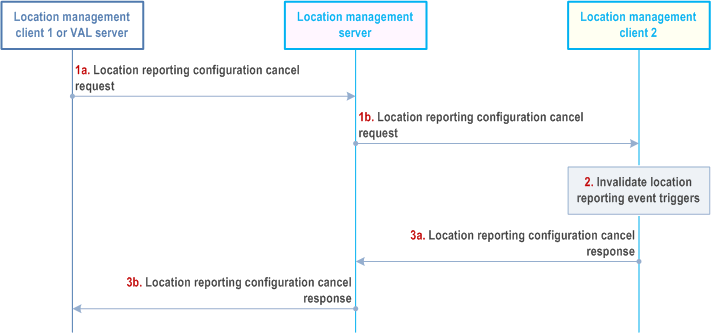
Step 1.
The location management client 1 (authorized VAL user or VAL UE) or VAL server sends a location reporting configuration cancel request to the location management server (1a). The location management server sends the location reporting configuration cancel request to the location management client 2 to stop receiving the UE location information (1b). This message can be sent via unicast or multicast.
Step 2.
The location management client invalidates the location reporting triggers configuration and no longer reports its location to the location management server.
Step 3.
The location management client 2 sends the location reporting configuration cancel response to the location management server (3a) as an acknowledgement. The location management server sends the location reporting configuration cancel response to the location management client 1 (3b) as an acknowledgement.
9.3.7 Location information subscription procedure p. 70
Figure 9.3.7-1 illustrates the high level procedure of location information subscription request. The same procedure can be applied for location management client and other entities that would like to subscribe to VAL user or VAL UE location information. This procedure is also used for initiating tracking a UE's location.
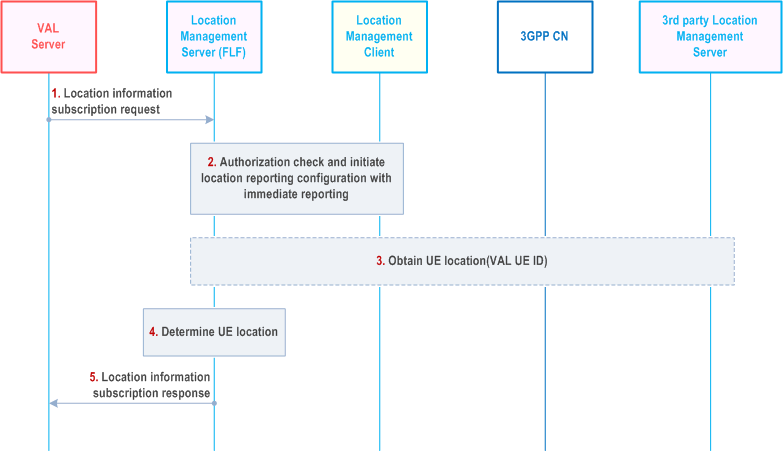
Step 1.
The VAL server sends a location information subscription request to the location management server to subscribe location information of one or more VAL users or VAL UEs. The request may include an indication for supplementary location information and the location QoS which contains the location accuracy, response Time and QoS class as defined in clause 4.1b of TS 23.273.
Step 2.
The location management server shall check if the VAL server is authorized to initiate the location information subscription request and may retrieve the available and proper location access type and positioning methods (e.g. as described in TS 23.273 and TS 29.572) for the target VAL UE based on the received location QoS. Further, the location management server may initiate location reporting configuration optionally including the retrieved location access type and positioning methods with the location management client of the UE for immediate reporting.
Step 3.
The location management server may optionally subscribe for UE location information from 3GPP core network for the UE. If the indication for supplementary location information is included in step 1, then UE location information is obtained from the 3GPP core network and/or the 3rd party location management server.
Step 4.
The location management server determines the UE location information of the UE as received in steps 2 and 3 and checks if it meets the location QoS requirements (if any) or not.
Step 5.
The location management server replies with a location information subscription response indicating the subscription status and if immediate reporting was requested, the location information of the VAL UE(s).
9.3.8 Event-trigger location information notification procedure p. 71
Figure 9.3.8-1 illustrates the high level procedure of event-trigger usage of location information. The same procedure can be applied for location management client and other entities that would like to subscribe to location information of VAL user or VAL UE. This procedure is also used for obtaining latest UE's location for tracking purpose.
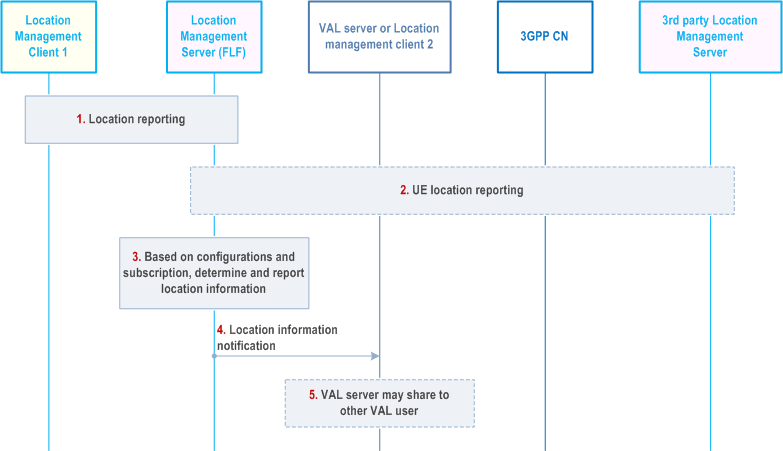
Step 1.
The location management server receives the latest location information of the UE as per the location report procedure described in clause 9.3.3.3.
Step 2.
The location management server may optionally receive the location information of the UE from 3GPP core and/or the 3rd party location management server network. If the indication for supplementary location information is included in the subscription, then UE location information is obtained from the 3GPP core network and/or the 3rd party location management server.
Step 3.
Based on the configurations, e.g., subscription, periodical location information timer, location management server is triggered to report the latest user location information to VAL server. The location management server determines the location information of UE as received in steps 1 and 2, including the supplementary location information (if indicated). The Location management server may report the location to the VAL server considering the location information received via non-3GPP positioning technologies (e.g. GNSS, Bluetooth), for instance, to improve the location accuracy.
Step 4.
The location management server sends the location information report including the latest location information of one or more VAL users or VAL UEs to the VAL server or to the location management client that has previously configured.
Step 5.
VAL server may further share this location information to a group or to another VAL user or VAL UE.
9.3.9 On-demand usage of location information procedure p. 72
The VAL server can request UE location information at any time by sending a location information request to the location management server, which may trigger location management server to immediately send the location report.
Figure 9.3.9-1 illustrates the high level procedure of on demand usage of location information. The same procedure can be applied for location management client and other entities that would like to subscribe to location information of VAL user or VAL UE.
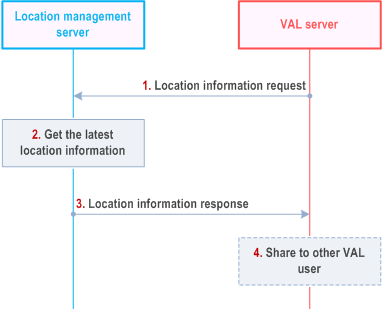
Step 1.
VAL server sends a location information request to the location management server which may include the location QoS that contains the location accuracy, response Time and QoS class as defined in clause 4.1b of TS 23.273.
Step 2.
The location management server acquires the latest location of the UEs being requested, by triggering an on-demand location report procedure as described in subclause 9.3.4, or from PLMN operator, and checks if the obtained location of the VAL UE could meet the location QoS requirements (if any).
Step 3.
Then, location management server immediately sends the location information report including the latest location information acquired of one or more VAL users or VAL UEs. The Location management server may report the location to the VAL server considering the location information received via non-3GPP positioning technologies (e.g. GNSS, Bluetooth), for instance, to improve the location accuracy.
Step 4.
VAL server may further share this location information to a group or to another VAL user or VAL UE.
9.3.10 Obtaining UE(s) information at a location |R17| p. 73
Figure 9.3.10-1 describes the procedure for obtaining UE(s) information at a location.
Pre-condition:
- The VAL server has a jurisdiction over a geographical area for which the location management server is configured to operate.
- The UE(s) in the geographical area have provided its location information to the location management server.
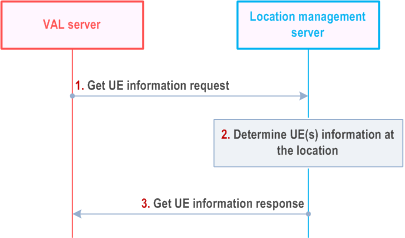
Step 1.
The VAL server sends get UE information request to the location management server. The request contains a location information or VAL service area identified by the VAL service area ID and application defined proximity range.
Step 2.
The location management server determines the UE(s) whose location are within the application defined proximity range of the location information or VAL service area identified by the VAL service area ID provided in step 1.
Step 3.
The location management server sends get UE information response to the VAL server with a list of VAL UE(s) or VAL user(s) and its corresponding location information as determined in step 1.